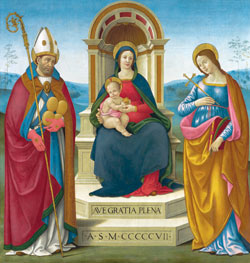Restored ‘Virgin of Guadalupe’ and Mainardi altarpiece are now on display

After a two-year restoration effort by a team of conservators, this altarpiece titled “Virgin and Child Enthroned with St. Justus of Volterra and St. Margaret of Antioch” is on display in the Clowes Courtyard at the Indianapolis Museum of Art. It was painted by artist Sebastiano Mainardi of Florence in 1507 during the height of the Italian Renaissance.
(Submitted photo/courtesy Indianapolis Museum of Art)
By Mary Ann Wyand
Restoring priceless and historic art is painstaking work that requires patience, precision and perfection.
Linda Witkowski, senior conservator of paintings-regional services at the Indianapolis Museum of Art, was among several conservators who worked on the restoration of “Virgin of Guadalupe,” a unique oil on canvas painting created by an unknown artist about 1700 in Mexico and purchased by the museum in December 2008. (See photos, page 1.)
It is on display in the museum’s “Sacred Spain: Art and Belief in the Spanish World” exhibit through Jan. 3.
“Ronda Kasl [senior curator of painting and sculpture before 1800] was instrumental in discovering the painting, and seeing that our museum could acquire it as one of the permanent paintings in our collection,” Witkowski said during an Oct. 8 interview. “Christina Milton O’Connell, an associate paintings conservator, worked on the painting as well and did a lot of preparatory work on it. … Laura Mosteller, a conservation technician, worked on the [ornate] frame, which also required a tremendous amount of work.”
Witkowski said “the painting was executed in Mexico and shipped to Spain, and then we acquired it from Spain so it is back in the Americas again.”
Kasl said this depiction of Our Lady of Guadalupe is significant because it includes four roundels, or scenes, that illustrate the story of the Virgin Mary’s appearance to Juan Diego at Tepeyac in Mexico between Dec. 9 and Dec. 12 in 1531 and her miraculous image on his tilma, or cloak.
The tilma’s perfectly preserved image of the Virgin Mary, shown pregnant with the Christ Child, is displayed for veneration in the Basilica of Our Lady of Guadalupe in Mexico City.
“The conservation of the painting and frame combined required about 1,000 hours of work,” Witkowski said. “It takes a certain temperament to be a conservator. You have to have patience as well as an understanding of art, art history and science.”
Witkowski also worked on the conservation team that recently completed a meticulous, two-year restoration of “Virgin and Child Enthroned with St. Justus of Volterra and St. Margaret of Antioch,” a 16th-century altarpiece painted by Italian artist Sebastiano Mainardi (1466-1513) of Florence, which has been on display in the museum’s Clowes Courtyard since June 23.
Commissioned in 1507 during the height of the Italian Renaissance, the Mainardi altarpiece was owned by American novelist and Indianapolis native Booth Tarkington before his widow donated it to the art museum in 1951.
This noteworthy example of Tuscan High Renaissance art was in storage at the museum for 40 years due to its fragile condition.
David Miller, senior conservator of paintings, was the Mainardi project director. Assisting him were Monica Griesbach of New York, a specialist in the structural treatment of paintings on wood panels; museum staff members Witkowski and Milton O’Connell; and graduate student intern Kathryn Campbell, who studied paintings conservation at Buffalo State College in Buffalo, N.Y.
Witkowski said the Mainardi altarpiece was painted with egg tempera, and had been damaged by dirt, soot from candles and several layers of varnish that had turned yellow over time.
“The Mainardi painting has probably been restored anywhere from three to five times in its history, probably about every 100 years or so, due to the accumulation of grime and soot from candles,” she explained. “Certain damages … made its conservation treatment rather challenging at times as to how to suggestively reconstruct lost and damaged areas of the painting. Fortunately, we had access to another painting executed by Mainardi in which the same figural groups were used. … We were able to reference that painting as [an example of] studio practices during the 1500s and earlier.”
The Mainardi altarpiece was commissioned to adorn the altar of a church, and is similar to a painting by the artist now displayed in an art museum in Italy.
Maxwell Anderson, museum director and chief executive officer, said in a press release last June that the completed conservation of this altarpiece, a magnificent work of art, is “a milestone for the [museum’s] conservation program.” †
